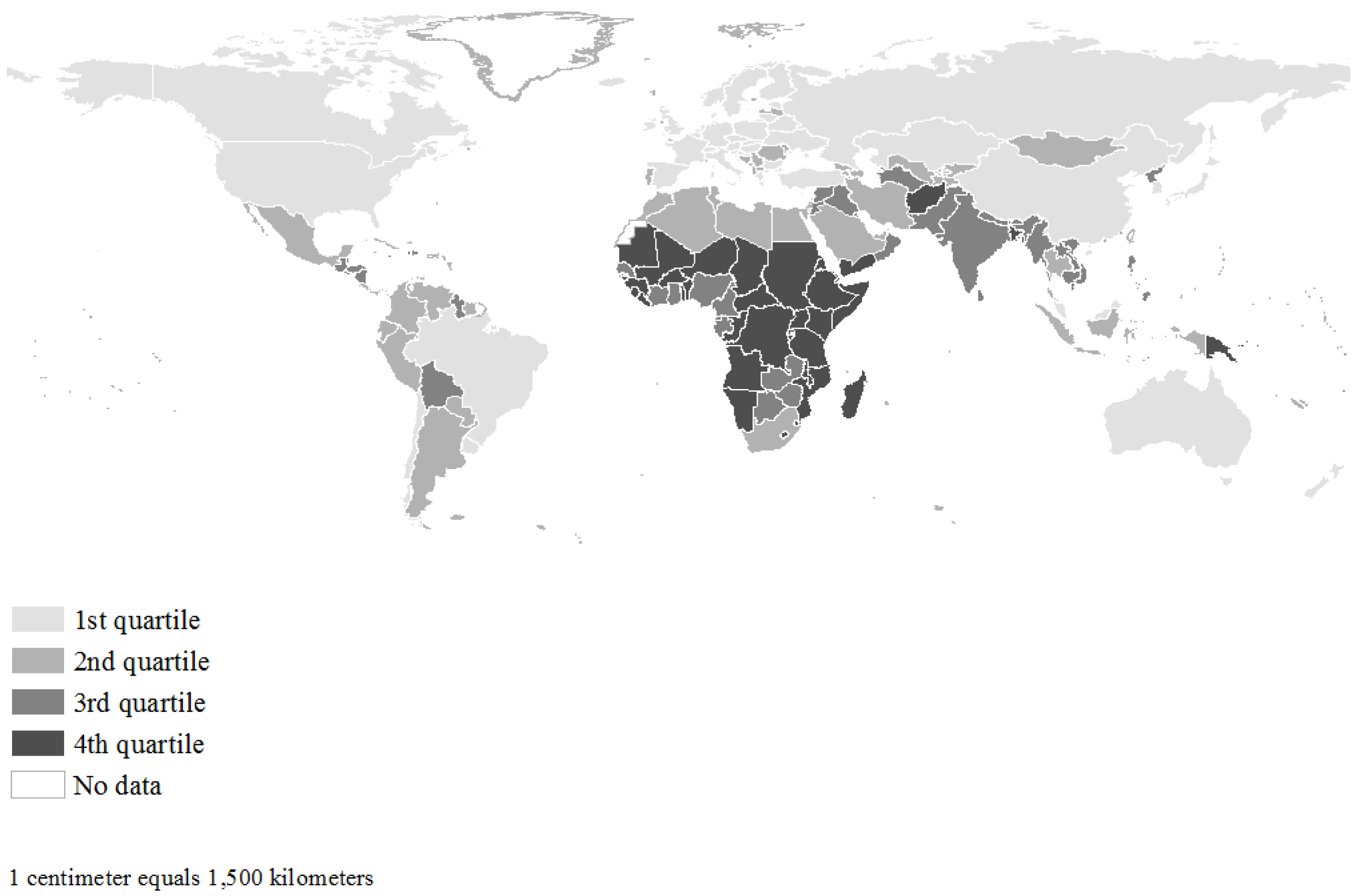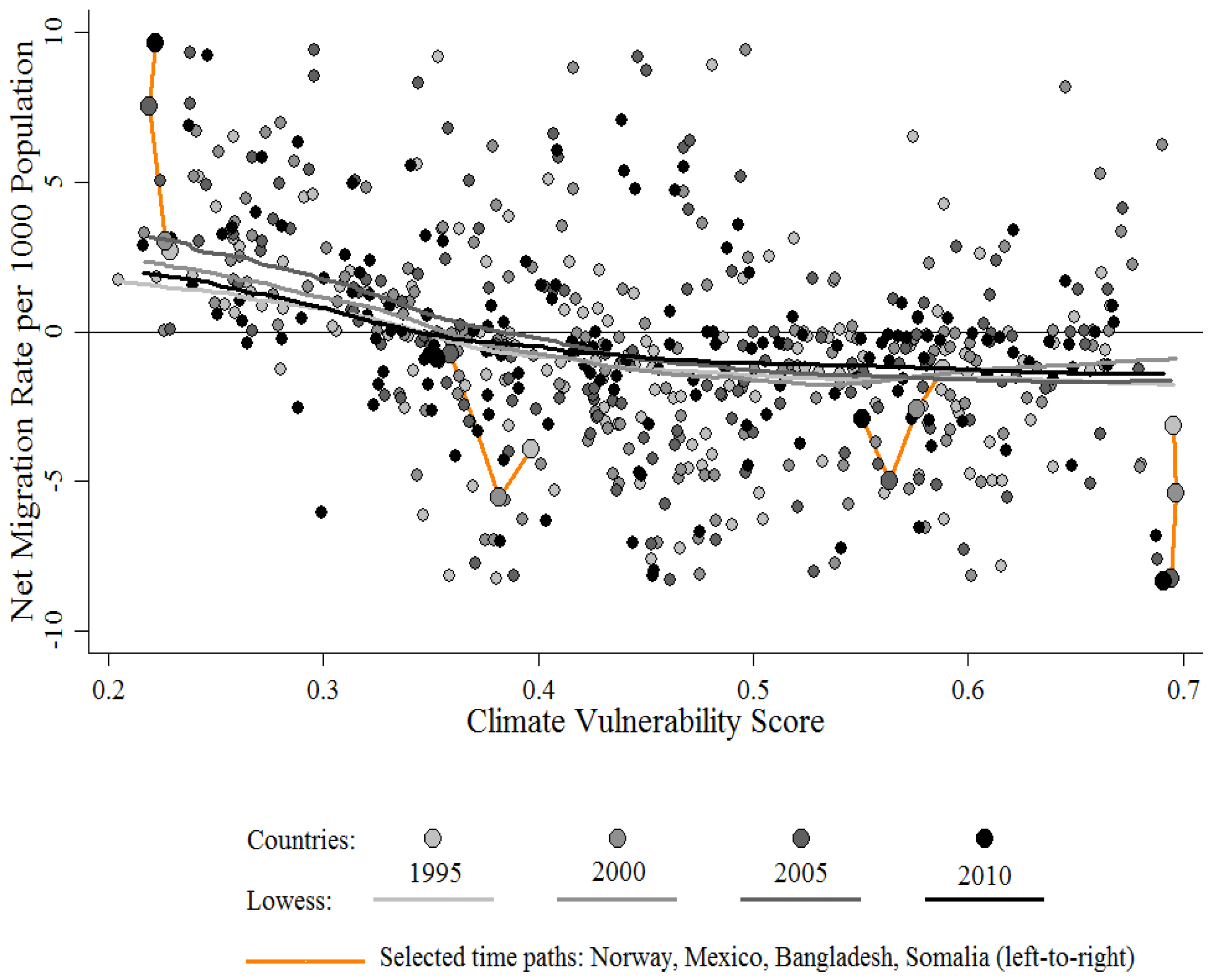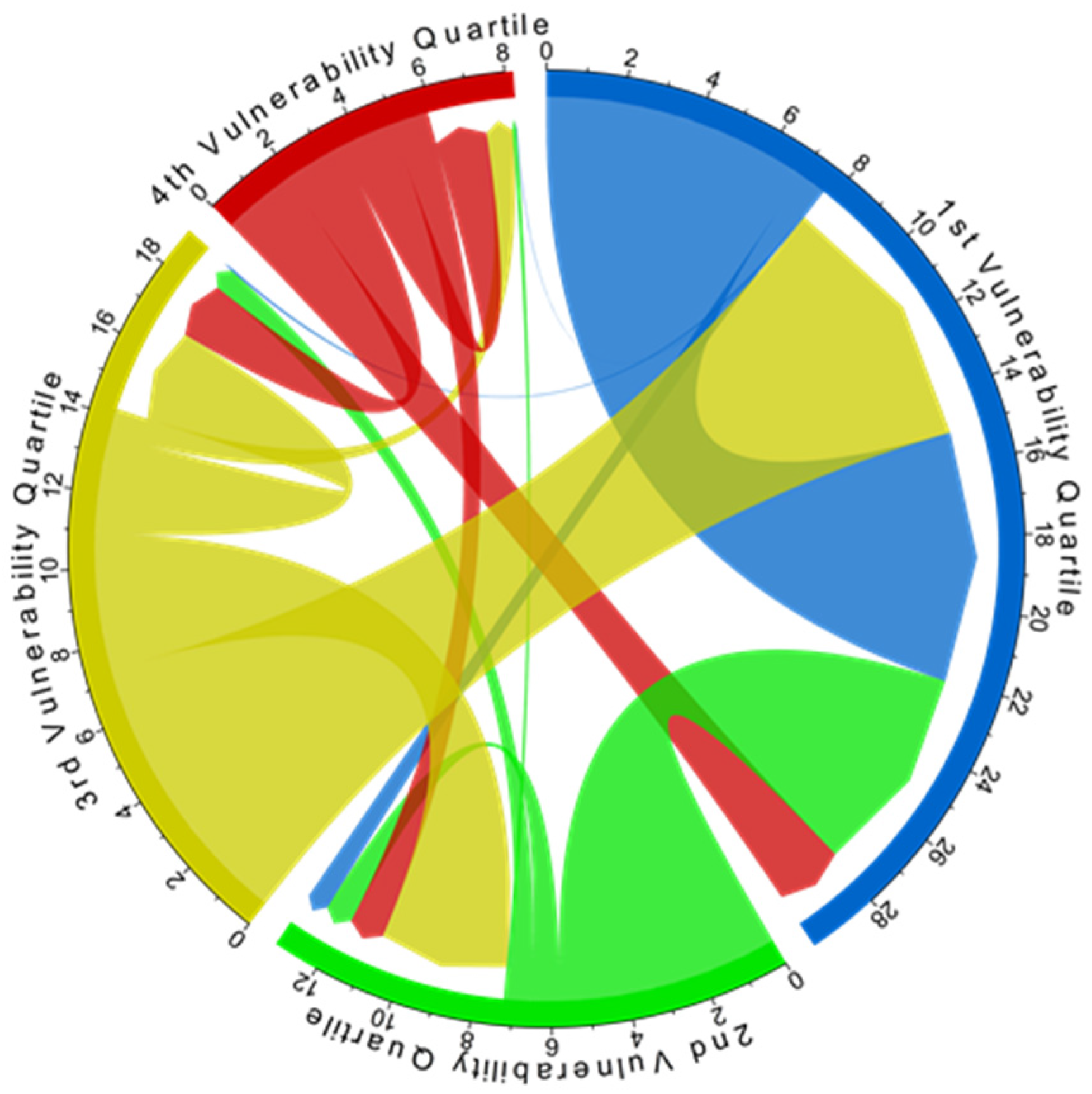Climate Vulnerability and Human Migration in Global Perspective
Abstract
:1. Introduction
2. Data
2.1. Climate Vulnerability Scores
2.2. International Migration Flows
3. Results
3.1. Spatial Patterning in Climate Vulnerability and Net Migration
3.2. Association Between Climate Vulnerability and Net Migration
3.3. Climate Vulnerability and Bilateral Migration Flows
4. Conclusions
Supplementary Materials
Acknowledgments
Author Contributions
Conflicts of Interest
References
- IPCC. Managing the Risks of Extreme Events and Disasters to Advance Climate Change Adaptation; A Special Report of Working Groups I and II of the Intergovernmental Panel on Climate Change; Field, C.B., Barros, V., Stocker, T.F., Qin, D., Dokken, D.J., Ebi, K.L., Mastrandrea, M.D., Mach, K.J., Plattner, G.K., Allen, S.K., et al., Eds.; Cambridge University Press: Cambridge, UK; New York, NY, USA, 2012; p. 582. [Google Scholar]
- International Organization on Migration (IOM). The State of Environmental Migration; Gemenne, F., Zickgraf, C., Ionesco, D., Eds.; IOM Publications: Geneva, Switzerland, 2015. [Google Scholar]
- Nawrotzki, R.J.; DeWaard, J. Climate shocks and the timing of migration from Mexico. Popul. Environ. 2016, 38, 72–100. [Google Scholar] [CrossRef] [PubMed]
- Vitousek, P.M.; Mooney, H.A.; Lubchenco, J.; Melillo, J.M. Human domination of earth’s ecosystems. Science 1997, 277, 494–499. [Google Scholar] [CrossRef]
- Vörösmarty, C.J.; Green, P.; Salisbury, J.; Lammers, R.B. Global water resources vulnerability from climate change and population growth. Science 2000, 289, 284–288. [Google Scholar] [CrossRef] [PubMed]
- Raudsepp-Hearne, C.; Petterson, G.; Tengo, M.; Bennett, E.M.; Holland, T.; Benessiah, K.; MacDonald, G.K.; Pfeifer, L. Untangling the environmentalist’s paradox: Why is human well-being increasing as ecosystem services degrade? BioScience 2010, 60, 576–589. [Google Scholar] [CrossRef]
- UNFCCC Task Force on Climate Displacement. Available online: http://unfccc.int/adaptation/groups_committees/loss_and_damage_executive_committee/items/9503.php (accessed on 10 April 2017).
- The Platform on Disaster Displacement. Available online: http://disasterdiplacement.org (accessed on 10 April 2017).
- 2030 Agenda on Sustainable Development. Available online: http://unofficeny.iom.int/2030-agenda-sustainable-development (accessed on 10 April 2017).
- Sandai Framework on Disaster Risk. Available online: http://www.unisdr.org/we/coordinate/sendai-framework (accessed on 10 April 2017).
- Hunter, L.M.; Luna, J.K.; Norton, R.M. Environmental dimensions of migration. Annu. Rev. Sociol. 2015, 41, 377–397. [Google Scholar] [CrossRef]
- McLeman, R.A. Climate and Human Migration: Past Experiences, Future Challenges; Cambridge Univercity Press: London, UK, 2014. [Google Scholar]
- McCubbin, S.; Smit, B.; Pearce, T. Where does climate fit? Vulnerability to climate change in the context of multiple stressors in Funafuti, Tuvalu. Glob. Environ. Chang. 2015, 30, 43–55. [Google Scholar] [CrossRef]
- Black, R.; Bennett, S.R.G.; Thomas, S.M.; Beddington, J.R. Climate change: Migration as adaptation. Nature 2011, 478, 447–449. [Google Scholar] [CrossRef] [PubMed]
- Chen, C.; Noble, I.; Hellman, J.; Coffee, J.; Murillo, M.; Chawla, N. Country Index Technical Report. University of Notre Dame—Global Adaptation Index. Released date. November 2015. Available online: http://index.nd-gain.org:8080/documents/nd-gain_technical_document_2015.pdf (accessed on 15 February 2017).
- Chen, C.; Hellman, J.J.; Berrang-Ford, L.; Noble, I.; Reagan, P. A global assessment of adaptation investment from perspective of equity and efficiency. Mitig. Adapt. Strateg. Glob. Chang. 2016, 1–22. [Google Scholar] [CrossRef]
- Abel, G.J. Estimating global migration flow tables using lace of birth data. Demogr. Res. 2013, 28, 505–546. [Google Scholar] [CrossRef]
- Abel, G.J. Estimates of Global Bilateral Migration Flows by Gender between 1960 and 2015; Working Paper 2; Vienna Institute of Demography: Wien, Austria, 2015. [Google Scholar]
- Department of Economic and Social Affairs, Population Division. World Population Prospects: The 2015 Revision, Key Findings and Advance Tables; Working Paper No. ESA/P/WP.241; United Nations: New York, NY, USA, 2015. [Google Scholar]
- Foresight. Migration and Global Environmental Change Final Project Report. (Government Office for Science). 2011. Available online: https://www.gov.uk/government/publications/migration-and-global-environmental-change-future-challenges-and-opportunities (accessed on 2 August 2016).
- Adger, W.N.; Arnell, N.W.; Black, R.; Dercon, S.; Geddes, A.; Thomas, D.S.G. Focus on environmental risks and migration: Causes and consequences. Env. Res. Lett. 2015, 10, 6. [Google Scholar] [CrossRef]
- Rogers, A. Requiem for the net migrant. Geogr. Anal. 1990, 22, 283–300. [Google Scholar] [CrossRef]
- Dabla-Norris, E.; Kochhar, K.; Suphaphiphat, N.; Ricka, F.; Tsounta, E. Causes and Consequences of Income Inequality: A Global Perspective. (IMF Staff discussion note). June 2015. SDN/15/13. Available online: https://www.imf.org/external/pubs/ft/sdn/2015/sdn1513.pdf (accessed on 20 December 2016).
- Timmons Roberts, J.; Parks, B. A Climate of Injustice; MIT Press: Cambridge, MA, USA, 2007. [Google Scholar]






© 2017 by the authors. Licensee MDPI, Basel, Switzerland. This article is an open access article distributed under the terms and conditions of the Creative Commons Attribution (CC BY) license (http://creativecommons.org/licenses/by/4.0/).
Share and Cite
Grecequet, M.; DeWaard, J.; Hellmann, J.J.; Abel, G.J. Climate Vulnerability and Human Migration in Global Perspective. Sustainability 2017, 9, 720. https://doi.org/10.3390/su9050720
Grecequet M, DeWaard J, Hellmann JJ, Abel GJ. Climate Vulnerability and Human Migration in Global Perspective. Sustainability. 2017; 9(5):720. https://doi.org/10.3390/su9050720
Chicago/Turabian StyleGrecequet, Martina, Jack DeWaard, Jessica J. Hellmann, and Guy J. Abel. 2017. "Climate Vulnerability and Human Migration in Global Perspective" Sustainability 9, no. 5: 720. https://doi.org/10.3390/su9050720





